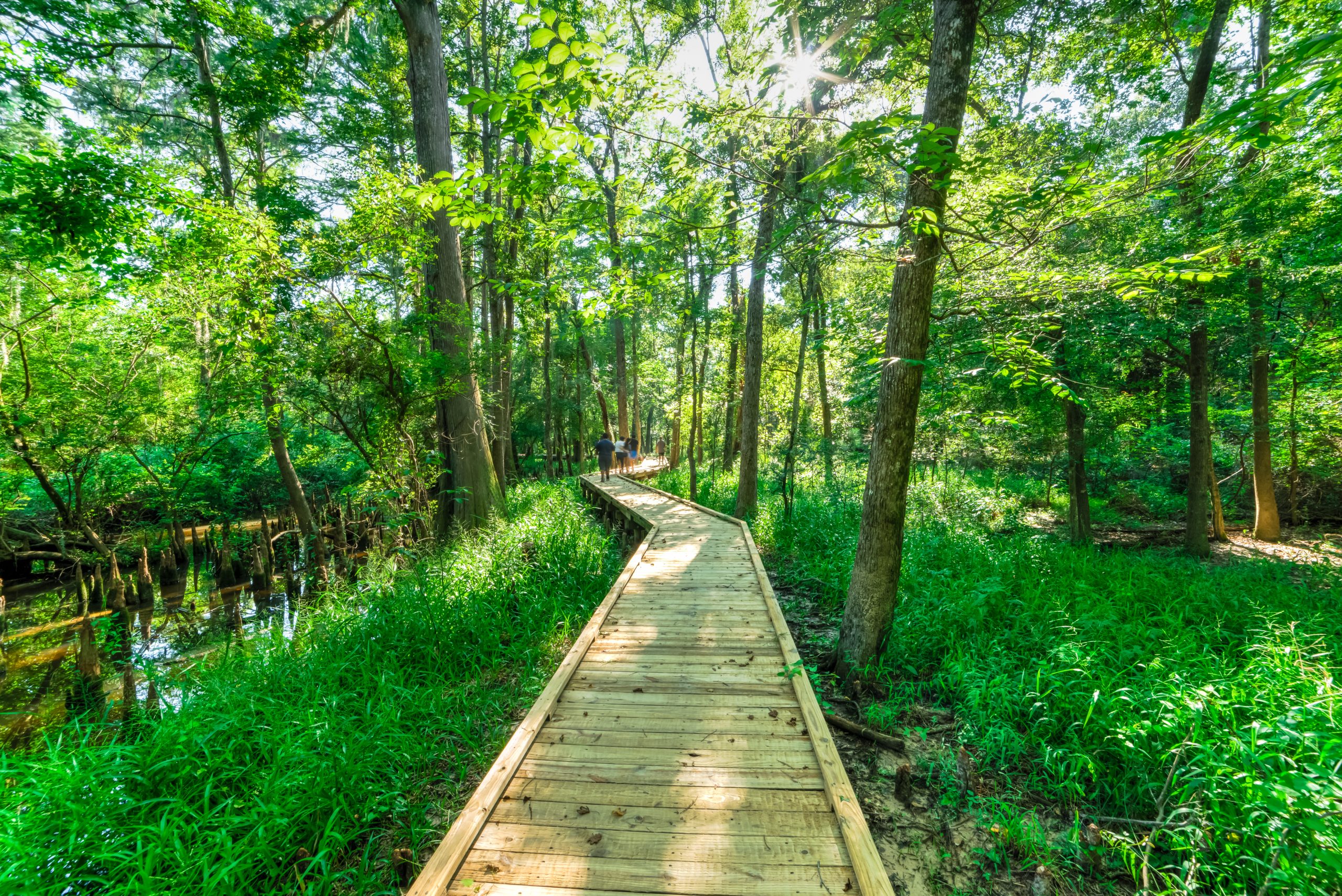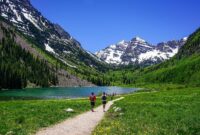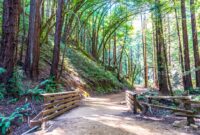Walking trails close to me offer a fantastic opportunity for exploration and exercise, right on your doorstep. This guide delves into discovering nearby walking paths, catering to diverse preferences and fitness levels. We’ll explore how to find trails using readily available resources, understand their difficulty, and even discover hidden gems in your local area, making the most of your outdoor adventures.
From identifying your location and preferences to utilizing various data sources and presenting the information clearly, we’ll cover the entire process of finding the perfect walking trail for you. We will also explore advanced features like user reviews, real-time trail conditions, and visual representations of elevation profiles and trail features to enhance your experience.
Understanding User Location & Preferences
To provide the most relevant and useful walking trail recommendations, our system leverages user location data and personalized preferences. This ensures that users are presented with options that are geographically accessible and align with their individual needs and interests. This process involves several key steps, as detailed below.
Accurately determining a user’s location and preferences is crucial for delivering a personalized experience. By understanding these factors, the system can effectively filter and rank potential trails, ensuring that users find trails that meet their specific requirements and are conveniently located.
User Location Determination
The system utilizes a combination of methods to pinpoint user location. Primarily, it employs IP address geolocation, which provides a general geographic area. For increased accuracy, particularly for mobile users, the system also integrates with geolocation services that leverage GPS data from the user’s device, if permission is granted. This dual approach enhances location precision, allowing for more targeted trail recommendations. The system prioritizes user privacy and complies with all relevant data protection regulations.
Trail Type Preferences
Users are presented with a selection of trail types to choose from, allowing them to specify their preferred walking surface. Options include paved trails, ideal for strollers and wheelchairs; dirt trails, offering a more natural experience; and mountain trails, catering to more experienced hikers. This preference is a key factor in filtering search results, ensuring that users only see trails that match their chosen surface type. For example, a user selecting “paved” will only see trails with paved surfaces listed in the results.
Trail Length and Difficulty Level Preferences
Users can further refine their search by specifying their preferred trail length and difficulty level. Length options might range from short, leisurely strolls to longer, more challenging hikes. Difficulty levels could be categorized as easy, moderate, or difficult, providing a clear indication of the trail’s terrain and overall challenge. These preferences are used in conjunction with trail type to generate a highly personalized list of suitable options. For instance, a user might specify a moderate difficulty level and a trail length of 5-10 kilometers, filtering out trails that are too short, too long, or of a different difficulty.
Accessibility Feature Filtering
The system incorporates a robust filtering mechanism for accessibility features. Users can specify whether they require wheelchair access, indicating a need for paved surfaces, gentle inclines, and minimal obstacles. This filter ensures that users with mobility limitations are presented with trails that are safe and easily navigable. For example, a user selecting “wheelchair access” will only see trails explicitly identified as accessible to wheelchairs. The system relies on verified data from trail databases and user reviews to ensure the accuracy of accessibility information.
Advanced Features & Enhancements
Enhancing the user experience beyond basic trail information requires incorporating advanced features that provide richer, more dynamic information and personalized interactions. This section details several key improvements that can significantly boost user engagement and satisfaction.
User Reviews and Ratings System Design
A robust user review and rating system allows users to share their experiences, providing valuable insights for others planning similar hikes. This system should include fields for star ratings (e.g., 1-5 stars), text reviews detailing specific aspects of the trail (difficulty, scenery, maintenance), and potentially photo uploads. Moderation of reviews is crucial to ensure accuracy and prevent inappropriate content. Data could be stored in a database with fields for user ID, trail ID, rating, review text, timestamp, and potentially a flag for moderation status. The system could also implement features such as flagging inappropriate reviews or allowing users to report inaccurate information. Averages and distribution of ratings could be displayed visually, alongside a sampling of recent reviews.
Comparison of Trail Rating Systems
Several rating systems exist, each with strengths and weaknesses. A simple star rating system is intuitive and easy to understand, but lacks nuance. More complex systems might incorporate multiple rating criteria, such as difficulty, scenery, and family-friendliness, allowing for a more detailed assessment. For example, a system could use a weighted average of individual criteria scores to arrive at an overall trail rating. The effectiveness of a system depends on the clarity of its criteria, the ease of use for both reviewers and users, and the ability to provide meaningful comparisons between trails. A well-designed system encourages participation and provides reliable, relevant information to users.
Integrating Real-Time Trail Conditions
Providing real-time trail conditions significantly enhances the utility of the application. This can be achieved through integration with weather APIs (e.g., OpenWeatherMap) to display current weather conditions at or near the trailhead. Further enhancements could involve integrating with official park or trail authority websites to display real-time trail closures or alerts (e.g., due to weather, maintenance, or other events). The system would need to regularly check these external sources for updates and present the information clearly to users. For instance, a simple color-coded system (green for open, yellow for partial closure, red for complete closure) could be used to quickly convey trail status.
Incorporating Trail Elevation Profiles
Visualizing trail elevation profiles is crucial for users to understand the difficulty and plan accordingly. This can be accomplished by integrating elevation data (potentially sourced from elevation APIs or mapping services) into the application. The elevation profile could be displayed as a line graph, showing elevation changes along the trail’s length. Key points, such as significant climbs or descents, could be highlighted. The profile could also be overlaid on a map for a more comprehensive visual representation. Furthermore, the system could calculate total elevation gain and loss, providing users with quantitative data about the trail’s difficulty. This feature allows users to make informed decisions based on their fitness level and experience.
Visual Representation of Trails
Effective visual representation of walking trails is crucial for user engagement and understanding. High-quality visuals enhance the user experience by providing a clear and informative overview of trail characteristics, difficulty, and points of interest. This section details how to generate images depicting various trail types and their key features.
Generating Images of Different Trail Types
Generating images of various trail types requires careful consideration of the environment and trail characteristics. For a scenic forest trail, the image should depict a winding path through a lush forest, possibly with dappled sunlight filtering through the trees and showcasing diverse flora. The path itself should be clearly visible, perhaps with fallen leaves or a mossy texture suggesting a natural, unpaved surface. The overall mood should be serene and inviting. A challenging mountain path image, conversely, would show a steep, rocky trail with potentially uneven terrain. The image might include elements like exposed rock faces, sparse vegetation, and perhaps a distant mountain vista to emphasize the difficulty and rewarding views. A paved urban walkway image should depict a smooth, well-maintained path, potentially with buildings, streetlights, or other urban features in the background. The image should convey a sense of accessibility and safety.
Visual Representation of Trail Elevation Changes
Visualizing elevation changes can be achieved through various methods. A simple approach involves using a line graph superimposed on a map of the trail. The x-axis represents the distance along the trail, and the y-axis represents the elevation. Steeper inclines would be represented by steeper lines on the graph. More sophisticated methods might incorporate 3D modeling to create a more realistic visual representation of the trail’s topography, offering a perspective that allows users to understand the elevation profile more intuitively. For example, a 3D model could show a trail winding up a hill, clearly indicating the ascent and descent points. Color-coding the elevation profile, with different colors representing different elevation ranges, can also enhance clarity and visual appeal.
Visual Representation of Trail Features
Trail features such as benches, viewpoints, and water sources should be clearly indicated on the visual representation. Benches can be depicted as simple icons along the trail. Viewpoints can be represented by a symbol indicating a panoramic view, perhaps with a small inset image showcasing the view itself. Water sources, like streams or fountains, can be represented with appropriate icons, clearly marked on the trail map. The style of the icons should be consistent and easily understandable. For instance, a stylized image of a bench, a pair of binoculars for a viewpoint, and a water droplet for a water source would be readily identifiable and visually appealing. The placement of these icons on the map should accurately reflect their location on the actual trail.
Final Summary
Ultimately, discovering and enjoying walking trails near you is about more than just physical activity; it’s about connecting with nature, exploring your surroundings, and finding peaceful escapes close to home. By utilizing the techniques and resources outlined in this guide, you can unlock a world of nearby trails, tailored to your individual needs and preferences, ensuring every walk is a rewarding experience.




